Posts Tagged: orange
On Making a Mountain Out of an Ant Hill
When you "make a mountain out of a molehill," you're exaggerating the severity of the situation. But if you're an ant, you can make little mounds...
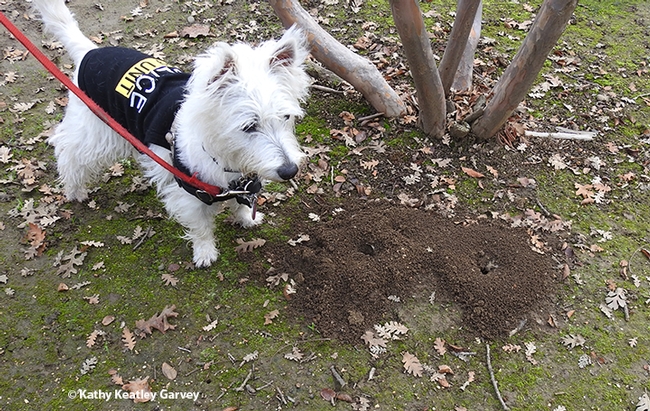
Piper, a West Highland white terrier, aka Westie, "polices" two carpenter ant mounds in a Vacaville park. (Photo by Kathy Keatley Garvey)
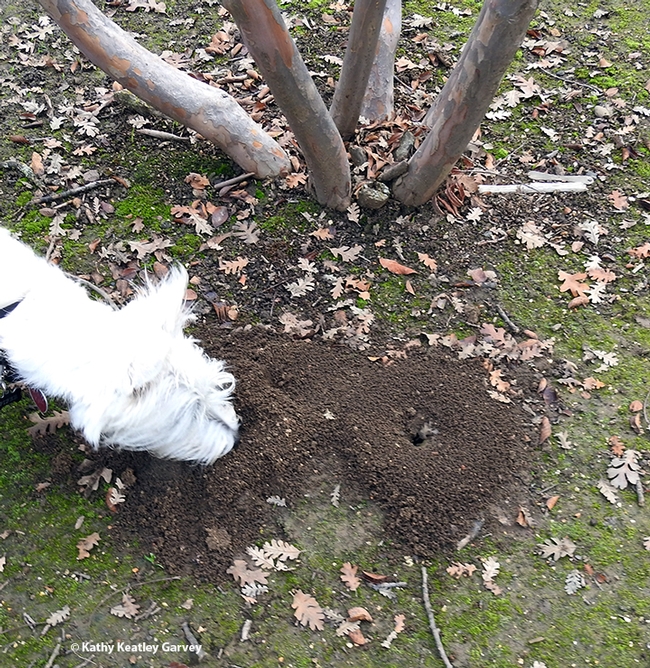
Being the curious sort, Piper, a West Highland white terrier, sniffs a carpenter ant mound in a Vacaville park. (Photo by Kathy Keatley Garvey)
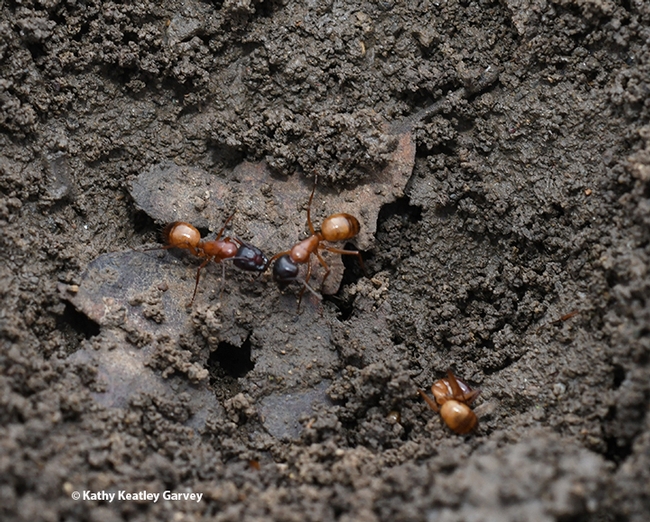
Close-up of carpenter ants, Camponotus semitestaceus (as identified by UC Davis-trained entomologist Brendon Boudinot). (Photo by Kathy Keatley Garvey)
Two Icons: Old Glory and the Glorious Monarch
Two icons, the American flag and the monarch butterfly, are flying high today. The American flag, or "Old Glory," symbolizes our democracy. The 13...
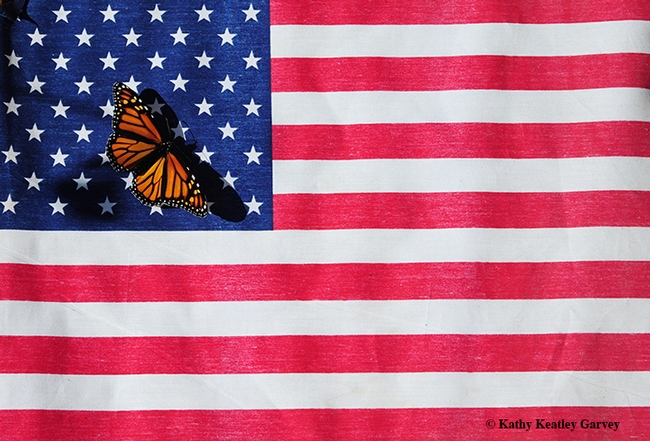
Two icons: the American flag, which represents our democracy, and the monarch butterfly, which is linked to a monarchy. The common name, "monarch," refers to "The Prince of Orange" who would later become known as King William III of England." (Photo by Kathy Keatley Garvey)
Seconds Count When You're Photographing Butterflies
When you're capturing images of butterflies, seconds count. They're unpredictable. They move from fluttering to fleeting. And just when you're...
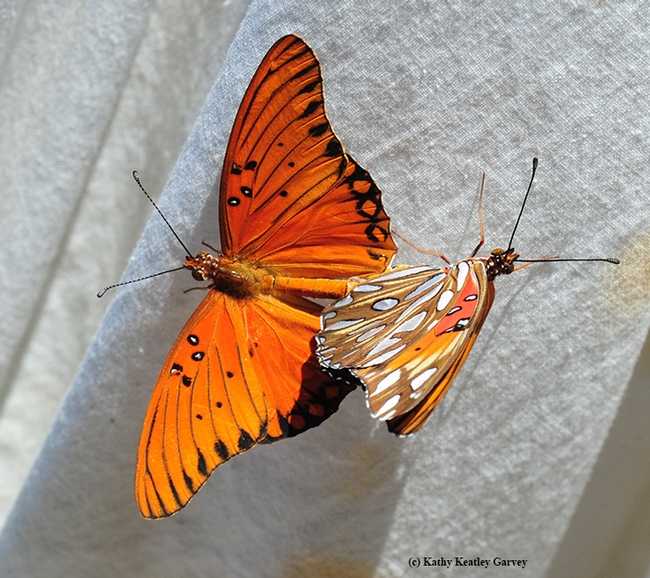
A mating pair of Gulf Fritillaries, Agraulis vanillae. Photo by Kathy Keatley Garvey)
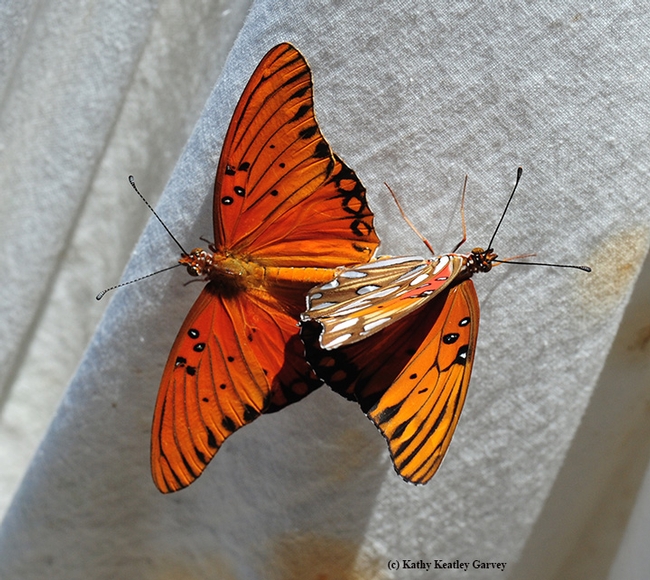
The mating Gulf Frits react to a breeze. (Photo by Kathy Keatley Garvey)
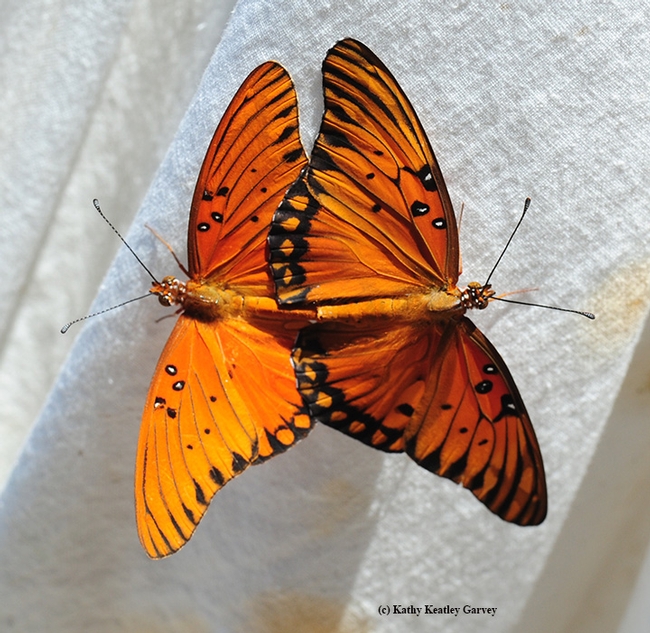
Synchronized Gulf Fritillaries. (Photo by Kathy Keatley Garvey)
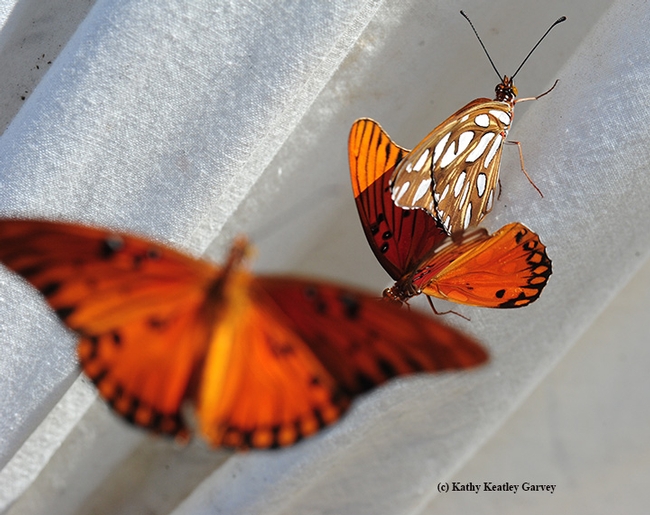
A territorial male Gulf Fritillary is just a blur as it heads over to the mating pair. (Photo by Kathy Keatley Garvey)
Orange Blossom Special
If you like oranges, you can thank a honey bee. Oranges are 90 percent dependent on honey bees for pollination. Remember that week of...
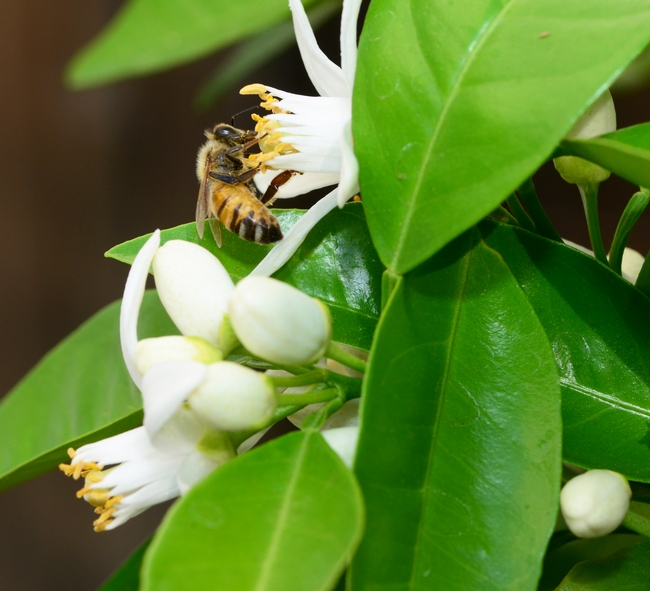
A honey bee pollinating an orange blossom. (Photo by Kathy Keatley Garvey)
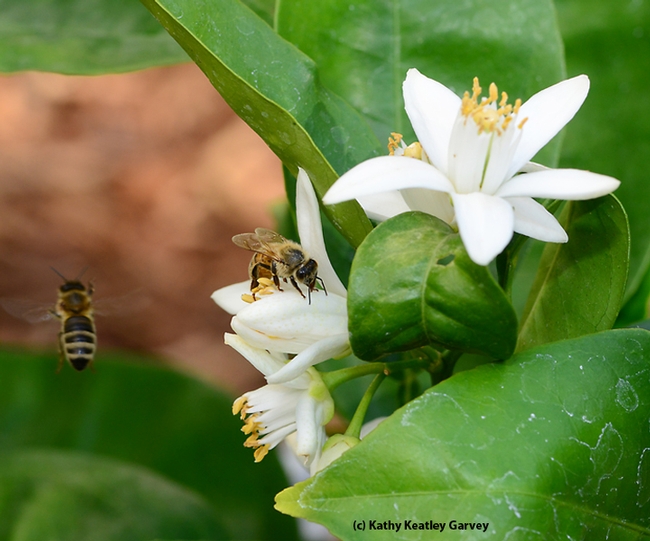
One bee forages while another takes flight. (Photo by Kathy Keatley Garvey)
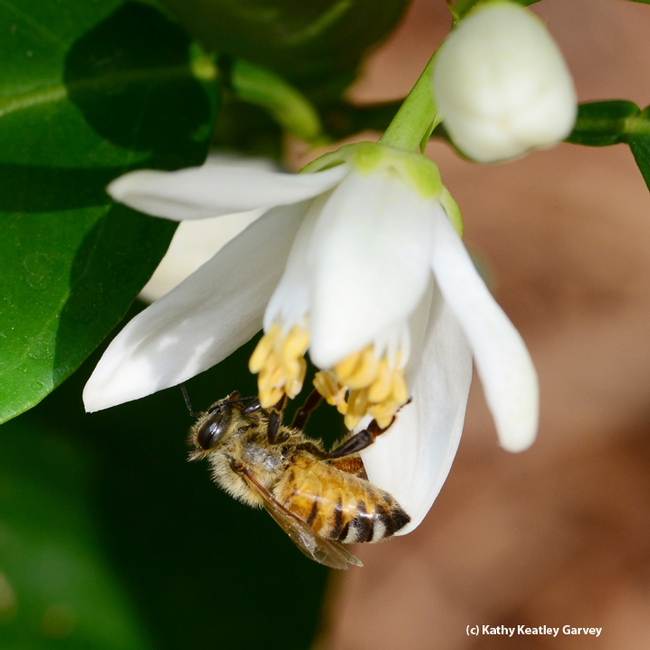
Close-up of honey bee on an orange blossom. (Photo by Kathy Keatley Garvey)
The Improved Meyer Lemon
The Meyer Lemon, Citrus x meyeri ‘Improved’, is a colorful presence in the winter garden. The tree’s green foliage punctuated with oblong orange-yellow fruit fits easily into holiday season decorations.
The Meyer lemon was introduced to the United States in 1908 by a U.S. Department of Agriculture plant explorer named Frank Meyer. He found the plant, a hybrid cross between a lemon and an orange near Beijing, China. The Meyer lemon was quickly introduced as a home orchard and container tree and sold primarily in the western United States. Unfortunately most of the Meyer lemon trees cloned until the early 1970’s were symptomless carriers of the Citrus tristeza virus (Closterovirus genus) a virus which causes decline, stem pitting and seedling yellows in citrus species and threatened the California citrus industry. This prompted regulations by the California Department of Food and Agriculture and the US Department of Agriculture to destroy most existing Meyer lemons. Fortunately, Don Dillon, a nurseryman, at Westwind Nurseries in Fremont California found a virus-free specimen that was subsequently certified and released by the University of California in 1972. All current Meyer lemons are derived from this virus free budwood and are sold as the Improved Meyer lemon, Citrus x myeri ‘Improved’.
The Meyer lemon is a thornless, shrubby, semi-dwarf plant well suited for container gardening. It can grow to six feet in containers but can be kept shorter by pruning. The usual rootstock is the Yuma Ponderosa lemon. The tree flowers intermittently during the year, providing lemons year-round although the heaviest set is in the spring. The blossoms are purple tinged and highly aromatic. The tree has cold and heat resistance comparable to sweet oranges and can be grown over a wider range than standard lemons or limes. It is hardy to 28 oF and can withstand short intervals of even colder temperatures.
The fruit is medium sized, oblong to elliptical with a thin, smooth, fragrant and tightly adherent yellow-orange rind. The fruit will self-store on the tree and the rind will become a deeper orange with time. The flesh is yellow to a light orange-yellow and very juicy with numerous seeds. The aroma and flavor of the Meyer Lemon is distinctive and the juice slightly acidic. The fruit has ben promoted as a ingredient in California cuisine by numerous chefs including Alice Waters. Its distinctive flavor has been added to salads, glazes, desserts and even bread. The ripe fruit is too tender and juicy to be successful as a commercial variety without significant loss during handling and shipment. The primary source of Meyer lemons for culinary use is from home-grown trees making the improved Meyer lemon one of the most widely grown home citrus varieties for both its fruit and ornamental beauty.
Try growing a Meyer lemon if you are looking for a productive, decorative tree that is relatively easy to care for. Meyer lemon trees need moderate water, especially in summer and container grown trees should never be allowed to completely dry out. Regular application of a citrus fertilizer will keep the foliage dark green and the tree productive. Although the Meyer lemon is susceptible to many citrus pests and diseases, well tended trees are generally pest and disease free. Management guidelines for citrus pests and diseases can be found in UC IPM Pest Management Guidelines for Citrus referenced below.
References:
- University of California Riverside Citrus Variety Collection:
http://www.citrusvariety.ucr.edu/citrus/improvedmeyer.html
- UC IPM Pest Management Guidelines for Citrus:
http://www.ipm.ucdavis.edu/PMG/selectnewpest.citrus.html
- Meyer Lemon Wikipedia Entry:
http://en.wikipedia.org/wiki/Meyer_lemon
- Discussion of the Improved Meyer Lemon Program:
Reuther, Walter; Leon Dexter Batchelor, E. Clair Calavan, Herbert John Webber, Glenn E. Carman, Robert G Platt (June 1989). Citrus Industry: Crop Protection. University of California. p. 195. ISBN 0-931876-24-9.
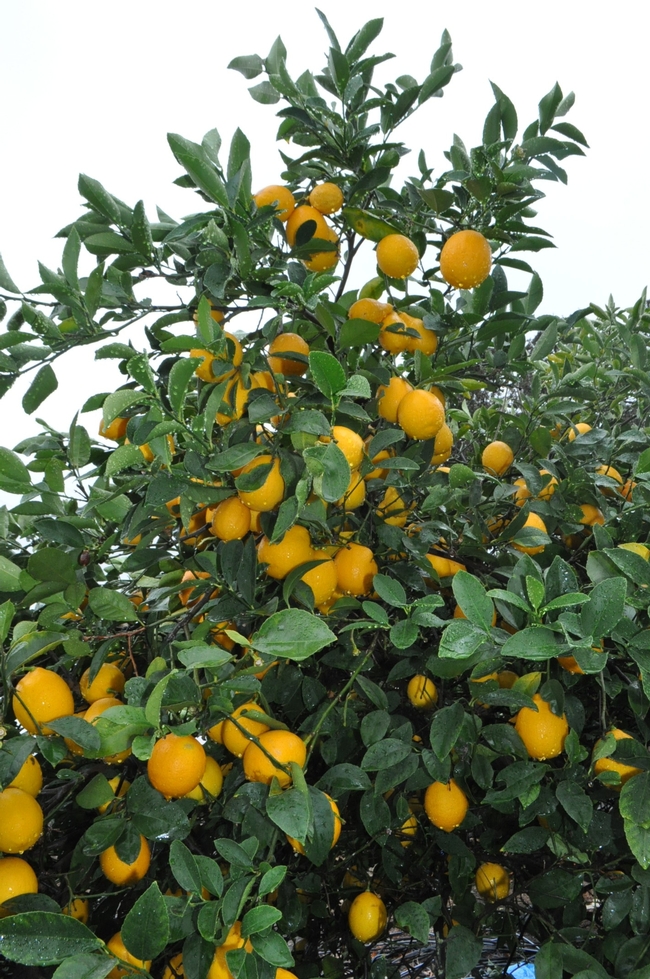
Improved meyer lemon. (photo by Rich Zimmerman)

